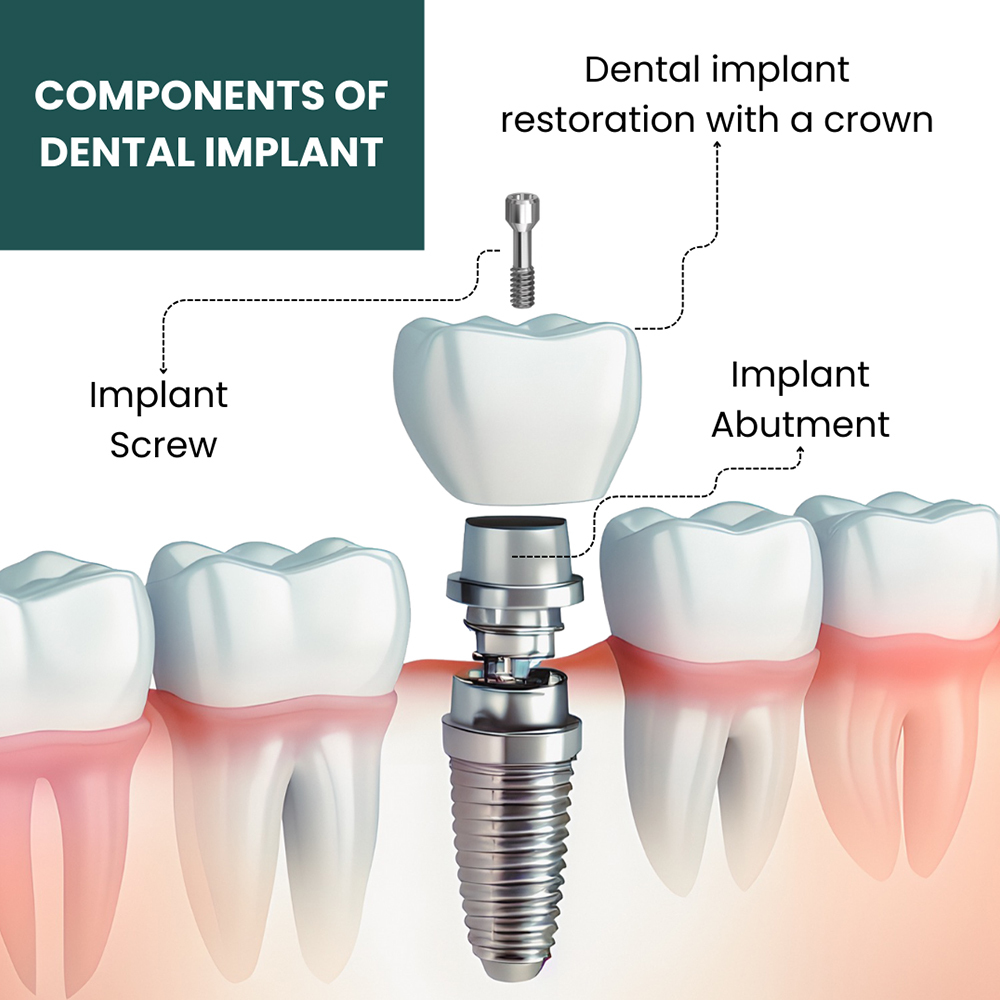Dental Implants Fundamentals Explained
Dental Implants Fundamentals Explained
Blog Article
The 7-Second Trick For Dental Implants
Table of ContentsThe 8-Second Trick For Dental ImplantsWhat Does Dental Implants Mean?The Definitive Guide to Dental ImplantsThe Definitive Guide for Dental Implants
are medical gadgets operatively implanted into the jaw to bring back a person's capability to chew or their look. They give assistance for fabricated (phony) teeth, such as crowns, bridges, or dentures. When a tooth is shed due to injury or disease, a person can experience problems such as fast bone loss, malfunctioning speech, or modifications to chewing patterns that cause pain.
Structure of The Oral Implant System picking dental implants, speak to your oral service provider about the possible benefits and dangers, and whether you are a candidate for the treatment. Things to consider: Your general health and wellness is a vital variable in identifying whether you are a good prospect for dental implants, how much time it will take to recover, and the length of time the implant may stay in location.
Smoking may impact the recovery process and decrease the long-lasting success of the dental implant. The healing process for the dental implant body might take several months or longer, during which time you usually have a temporary joint instead of the tooth. the oral implant treatment: Meticulously follow the oral hygiene directions provided to you by your oral supplier.
Getting My Dental Implants To Work
Implant failure can cause the need for one more surgery to repair or replace the implant system. Restores the capability to chew Restores aesthetic look Assists maintain the jawbone from reducing due to bone loss Protects the health and wellness of the surrounding bone and gum tissues Aids keep nearby (nearby) teeth stable Improves lifestyle Damage to bordering all-natural teeth throughout implant positioning Injury to the surrounding cells during surgical treatment, such as sinus opening Injury during surgical procedure (for instance, fracture of bordering jawbone) Inadequate function, such as seeming like the teeth do not attack together normally An experience that the tooth hangs or twisting in location resulting from an abutment screw loosening Implant body failure (looseness of the implant body) as a result of systemic infection, which may be more likely in individuals with unchecked diabetics issues due to local infection in bone and periodontals supporting the dental implant body due to delayed recovery, which might be most likely in patients that smoke Trouble cleaning up the periodontals around the dental implant, leading to poor oral hygiene Without treatment periodontal condition Post-surgical numbness as a result of nerve impingement or damage Constantly notify health care carriers and imaging specialists that you have dental implants prior to any magnetic vibration imaging (MRI) or x-ray procedures.
FDA is not familiar with any type more of damaging events reported for MRI or x-ray procedures with dental implants. Dental implants systems are typically made from materials that adhere to worldwide agreement standards of the International Company for Standardization (ISO) or ASTM International. These criteria have details of what makes a risk-free product.
Various other products such as gold alloys, cobalt-based alloys, titanium alloys, or ceramic products are occasionally used. The safety accounts of these products are widely known. Dental implant systems are reviewed according to international consensus standards. Biocompatibility testing, to show that bodily contact with the device does not cause issues like irritation or allergy, becomes part of the analysis that helps ensure the materials in the dental implant system are secure and do not trigger negative results when implanted in people.

Everything about Dental Implants
Some people are not eligible for oral implant surgery. It is for oral doctors to run on people with: severe illnessuncontrollable metabolic diseasebone or soft tissue illness or infectionIf these issues are resolved, a person can have the surgery. Dental Implants. In, dental specialists avoid running on people with: If individuals with any one of the above undergo oral implant surgical procedure, there is a higher danger of the implant failing
Some individuals have a jawbone problem that stops adequate bone for an implant from developing. The surgeon will then make use of a bone or bone replacement to fix and develop up the area.
Oral dental implant surgery is a customized procedure. It's not the exact same for everybody. The complying with provides a general summary of what you can expect your dental professional, oral doctor, periodontist or prosthodontist to do: Place the dental implant surgically. Provide you time to recover. Affix the message and last crown, bridge or denture.
Next off, your doctor will carefully place the dental implant into your jaw. If your implant is near the front of your mouth, your dental expert will make a short-lived tooth for you to put on until you recover.
Getting The Dental Implants To Work
Your company can inform you what to anticipate in your scenario. During the recovery stage, your jawbone should fuse to the dental implant. This procedure, called osseointegration, is crucial for security and long-term success. This process can take anywhere from 3 to 9 months. In many cases, it might take longer.
Once your implant heals, your dental professional can connect the joint (small connector blog post) and your final restoration (crown, bridge or denture). This normally Read More Here takes regarding one hour to complete and may require a second minor surgery. You should not feel any type of pain throughout your oral implant procedure since your provider will use drug to numb your gums.
Report this page